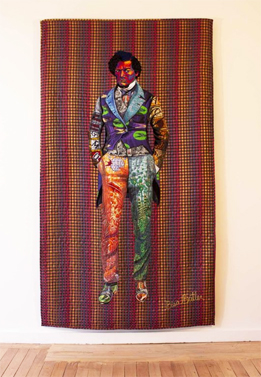|
Toledo Museum of Art
acquires major new work by contemporary artist Bisa Butler
The artwork’s
title, The Storm, the Whirlwind, and the Earthquake,
references a speech by Frederick Douglass on July 5, 1852
TOLEDO, Ohio – The Toledo
Museum of Art has added a monumental quilted portrait of the
19th-century abolitionist and social reformer Frederick
Douglass by acclaimed contemporary artist Bisa Butler to its
collection. The new work, The Storm, the Whirlwind, and the
Earthquake (2020) is a tour-de-force composition made
entirely of quilted and appliqued cotton, silk, wool and
velvet, depicting Douglass at full-length human scale
against a vibrant patterned background.
|
 |
|
Born in 1973 in Orange, New
Jersey, and currently living and working in West Orange,
Butler studied fine art at Howard University and
subsequently earned a master’s degree in art education from
Montclair State University. Prior to turning to artmaking
full time, Butler taught art in the South Orange and
Maplewood, New Jersey public schools. Though her training
focused on painting, Butler discovered that quiltmaking and
fiber art allowed her to more fully articulate, reclaim and
honor the countless contributions and untold histories of
African Americans. Butler learned to sew from her mother and
grandmother long before she began to paint. Employing
wax-printed fabrics from Ghana, her father’s homeland, as
well as kente cloth and Dutch wax prints, Butler engages in
a meaningful and dynamic conversation with traditional
African textiles. The artist also builds upon the legacy of
African American quiltmaking, feminist craft strategies of
the 1970s and 80s, and the collage techniques of Romare
Bearden.
“In my work, I am telling the
story – this African American side – of the American life.
History is the story of men and women, but the narrative is
controlled by those who hold the pen. My community has been
marginalized for hundreds of years. While we have been right
beside our white counterparts experiencing and creating
history, our contributions and perspectives have been
ignored, unrecorded and lost,” states Butler.
Brimming with vitality,
dignity and power, the life-sized figures in Butler’s
painterly textiles connect with viewers eye-to-eye,
conveying a sense of shared humanity and mutual respect. The
artist’s creative process consists of mining archival
photographs of African Americans, recreating the forgotten
faces and unsung personalities through methodical planning
and layering of vibrant colors and textures of fabric and
ultimately sewing the final quilt into place. “I represent
all of my figures with dignity and regal opulence because
that is my actual perspective of humanity,” says Butler.
After escaping slavery,
Douglass (1817-1895) became an influential orator, writer
and leader of the abolitionist movement. The work’s title
references a famous line from a July 5, 1852, speech, in
which Douglass, alluding to a July 4 pyrotechnic display,
admonished the celebration of freedom during a time of
slavery: “It is not the light that we need, but fire; it is
not the gentle shower, but thunder. We need the storm, the
whirlwind, and the earthquake.” Douglass was the most
photographed person of the 19th century, and his likeness in
this quilt is a composite of several photographic sources,
which captures the subject’s conviction and perseverance.
The artwork will be on view
beginning this summer. The Storm, the Whirlwind and the
Earthquake will be installed alongside works from TMA’s
permanent collection that have been selected by Butler in
collaboration with the curatorial team.
The Storm, the Whirlwind, and
the Earthquake will also be included in the upcoming group
exhibition Radical Tradition: American Quilts and Social
Change, which will be on view exclusively at TMA from Nov.
21, 2020, through Feb. 14, 2021. Curated by Lauren Applebaum,
Ph.D, the Museum Leadership Fellow at TMA, the exhibition
will bring historical and contemporary works together in
critical dialogue to explore how quilts have been used to
voice opinions, raise awareness, and enact social reform in
the U.S. over the past two centuries. The exhibition is
supported in part by 2020 Exhibition Program Sponsor
ProMedica, Checker Distributors and the Ohio Arts Council.
“Upon seeing images of this
inspiring textile before its completion, and later viewing
it in person during a visit with Bisa in her studio this
past January, I knew this work and the artist’s overarching
message would resonate deeply with all of the communities we
serve,” said Applebaum. “Douglass is a monumental figure in
American history and the struggles over racial equality that
he fought for still persist in our society and our
institutions today. Through her work, Butler pointedly and
importantly asks audiences to reconsider their assumptions,
values and actions going forward.”
As Butler has said, “I am
inviting a reimagining and a contemporary dialogue about
age-old issues, still problematic in our culture, through
the comforting, embracing medium of the quilt. I am
expressing what I believe is the equal value of all humans.”
Butler’s work was most
recently the focus of a solo exhibition at the Katonah
Museum of Art in New York that will subsequently travel to
the Art Institute of Chicago. Her works are included in the
collections of the Art Institute of Chicago; Minneapolis
Institute of Art; Museum of Fine Arts, Boston; Nelson-Atkins
Museum of Art; Newark Museum of Art; and Orlando Museum of
Art, among others. In 2019 Butler was a finalist for the
Museum of Arts and Design Burke Prize. Her portrait of Nobel
Peace Prize Laureate Wangari Maathai was featured as a cover
for Time Magazine’s special issue honoring the 100 Women of
the Year in 2020.
|